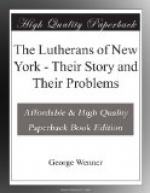Now some of our ministers, as far back as Falckner in the beginning of the century, belonged to the Halle or Francke school of Lutheranism, and the spirit of our church life at this time, as may be seen from the letters of Muehlenberg in the “Hallesche Nachrichten,” was not alien to that which the Palatines had imbibed from John Wesley, himself a product of the Pietistic movement of which Halle was the fountain head. One would suppose that these Palatine immigrants from the west of Ireland might have found a congenial home in the Lutheran Church and contributed to the spiritual life of the congregation. But for some reason they did not. They withdrew from us and helped to organize in 1766 the first Methodist Society in America.
The Methodists of America number seven million communicants. Barbara Heck, Philip Embury and other Palatine immigrants were our contribution to their incipient church life in America.
In the Nineteenth Century 1801-1838
The history of our churches in the nineteenth century may be divided into three periods. The first extends from 1801 to 1838.
At the beginning of the century there were two congregations, the German-English Church on Frankfort Street and the English (Zion) on Pearl Street.
In 1802 two hundred members of the German church who had not united with Zion in 1797 asked for a separate English church. The request was declined, but regular services in English were held in the afternoon with promises of a new church as soon as possible.
In 1804 Strebeck, the pastor of Zion, joined the Episcopalians and subsequently became rector of St. Stephen’s Church. Here he was followed in the course of years by a constant procession of his former parishioners. It will be recalled that Zion had not been received into connection with the Ministerium.
In 1805 Ralph Williston was chosen pastor. In 1810 he also became an Episcopalian. Not long after, the entire congregation followed him into the Episcopal fold. The resolution effecting the change read as follows:
“Whereas, many difficulties attend the upholding of the Lutheran religion among us, and whereas, that inasmuch as the doctrine and government of the Episcopal Church is so nearly allied to the Lutheran, and also on account of the present embarrassment of the finances of this church, therefore
“RESOLVED, That the English Lutheran Church
with its present form of worship and government be
dissolved after Tuesday, the 13th day of March next,
and that this Church do from that day forward become
a parish of the Protestant Episcopal Church, and the
present board of officers of this church take every
measure to carry this resolve into effect."*
On West Fifty-seventh
Street, a few steps from Carnegie Hall, the
visitor interested fn Lutheran antiquities may find
the stately Episcopal Church of Zion and St. Timothy.
It has a membership of 1,300. Its communion vessels
still bear the inscription: ZION LUTHERAN CHURCH.




